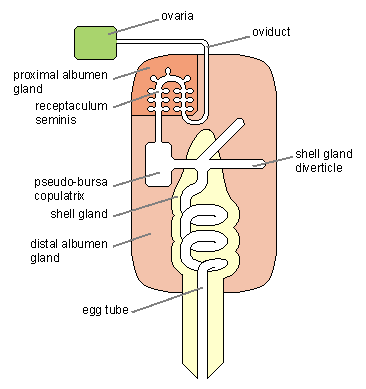Snails are considered to be hermaphrodites. This means that every snail will have both male and female reproductive organs. This is especially consistent among land snails and most marine snails.
The only snails that have not adapted this attribute are some freshwater and marine species, specifically including Apple Snails and periwinkles. These two types of snails still have a separate male and female species and are called Dioecious.
All snails will be considered sexually mature by the time they are one year old. This is because the life span of most species does not last for more than five to seven years, allowing for a faster growth rate of the species.
Structure of snails
Reproduction
hermaphrodites:
Common snails, like all land snails, are hermaphrodites. This means that they possess both male and female reproductive organs. Despite this they still need to find another snail to mate with. When two snails meet during the breeding season (late spring or early summer), mating is initiated by one snail piercing the skin of the other snail with a calcified 'love dart'. The exact purpose of the 'love dart' is not fully understood but it seems to stimulate the other snail into exchanging small packets of sperm. After mating is complete the snails will produce eggs internally, which are fertilised by the sperm that has been exchanged. Up to about a month after mating the snail lays about a hundred small white eggs in a nest underground in damp soil. If the conditions remain suitable for the eggs, snails will begin to hatch after about 14 days. Newly hatched snails have a small fragile shell and it takes two years for them to reach maturity.
Reproduction
Dioecious.
Usually takes place in water.
Male reproductive system:
During mating activities, this penial papilla bends towards the sperm groove in which the sperm is conducted. From this sperm groove the sperm is conveyed in the penial duct at the base of the penis.
The penis itself is coiled in a basal pouch (penial sac) when not used. On erection the penis comes out of the penial sac and is grasped around on the lower thirth by a muscular penial sheath from the mantle. It's the latter, which can be seen when the snails are mating. The real penis is rather thin, whip-like and often stays out of sight.
Female reproduction system:
The egg cells of the female snail are stored in the ovaria, which are located in the top of the spine, closely to the digestive gland.
 Normally the penis sheat is folded inside the mantle cavity, but sometimes it folded outwards and visible.
Normally the penis sheat is folded inside the mantle cavity, but sometimes it folded outwards and visible.Reflection
I'd taken some snails home and fed them once last year only because I found they were fun to play with. I put the box which had snails in on my bookshelf, and as a result, my chemistry assignment book ended being eaten up several pages. That incident irritated me very badly, so I threw these snails out of my house.
At that moment of time I thought they were only stupid soft animals moving aimlessly, and they carried their heavy "houses" (shell) wherever they went to.
But after finishing the research about the snails, I changed my mind as I'd realised that they actually had their own greatness. Their organs are so specialised and each of them is unique, working to serve their respective purposes. They possess specially designed "love dart" for their mates to touch as triggers as if they are small caring machines who'd considered a lot to change their body structures just to make their mates feel convenient. Wow, the nature is just so amazing for creating so many creatures like them.
Some dioecious snails release their sperms and eggs into water, making fertilisation can only occur by chance. That is undoutedly a tough job for snails to do, but they manage to make it and each of them contribute its own power to prevent the extinction of their species from happening. We all know how slow a snail moves, it must be traveling a extremely long distance to meet its mate. Some probably even have to fight against the currents of river to survive and get themselves fertilised.
The story of snails is very impressive, now I've learnt to respect and appreciate the nature. I think every living organism must have its own value and reason to be here. As the masterpieces of our mother earth, we are all equally great.









No comments:
Post a Comment